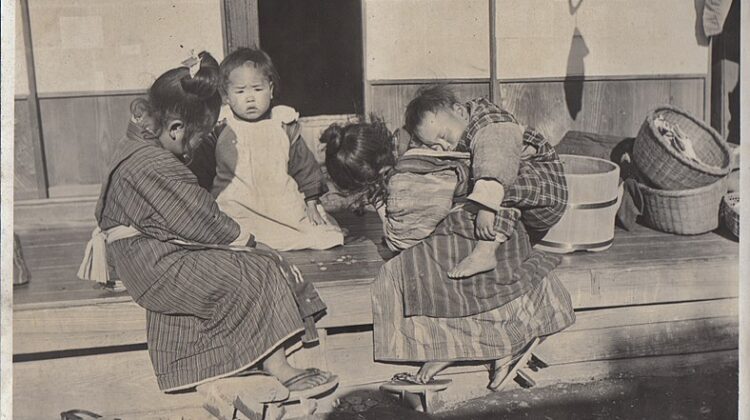
Photograph: Belongs to A.Davey, 1 September 1914, This file is licensed under the Wikimedia Commons Creative Commons Attribution 2.0 Generic license[1].
We really like this photograph! Each girl is baby-sitting a child younger than her. Look at their “geta sandals”. These are designed to keep your feet dry and it looks like they need them in that yard. There is a third pair of sandals up next to the porch. These are a different type wooden platform sandals and they were often lacquered and painted. This pair looks plain and they probably belong to mother who is inside the house.
Also check out the work baskets without handles. Some were made of bamboo while others were made of wood roots. Finally, look at the wooden barrel on the porch. It looks new. This stave barrel may be a okamochi or mokko which was used for storing sake, rice, and other foods.
An Introduction To Ohajiki
And what are the kids doing while they work? Playing Ohajiki. While researching and writing our story “Manzanar: A Second Look at Camp Marbles” (https://thesecretlifeofmarbles.com/manzanar-a-second-look-at-camp-marbles1/) we were introduced to Ohajiki by Aiko Suzuki (user name Shiraaiko), a new confrère who lives in Yamagata, Japan. She told us what ohajibi are and allowed us to use this gorgeous photograph of some opaque flat game pieces. We recommend that you check out the Manzanar story.
Ohajiki Is A Traditional Japanese Game
Yabai tells us that Ohajiki is written in Japanese as おはじき but we have also read that it takes its name from the verb “flick” which in Japanese is hajiku (フリック).
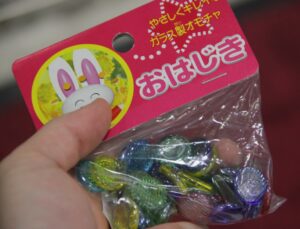
By Kyle McDonald [CC BY 2.0 (https://creativecommons.org/licenses/by/2.0/)],
via Wikimedia Commons
This is a bag of modern Ohajiki made of glass. Modern game pieces generally have the criss-cross pattern seen in the photograph on both sides. This design probably does make it easier to grip the pieces while playing.[2] Modern pieces are also made of plastic which are very thin and, generally, have no patterns at all.
Unlike other traditional Japanese games such as the strategy game Go[3], there is no board used with ohajiki. Go is played with black and white stones and, like ohajiki, it is played by two enthusiasts. We have read that ohajiki is also called Go. It is not at all the same game although both are historic and deeply embedded in the Japanese culture. Ohajiki may be called Go because Go pieces are about the same size and they make excellent ohajiki pieces. We are sure that children playing ohajiki have adapted and used Go pieces.
The Chinese Influence
We have read a number of sources[4] which tell us that ohajiki started in Japan as early as the Nara period (AD 710–784). This certainly makes sense because we have read again and again that the game came originally from China. During the Nara period the first permanent imperial capital was at Nara and the city itself was modeled on the Chinese T’ang dynasty (AD 618 – 907) capital at Ch’ang-an[5].
The Chinese influences during the Japanese Nara period were persuasive in law and the Chinese language and literature were studied intensively in Japan. Some Chinese characters were even adapted to the Japanese language.
And doubtless the Chinese also influenced Japanese game play. Popular games in China at the time included the Game of Leaves, which is generally considered the world’s first card game[6].
When introduced to Japan, ohajiki was played by adults and, curiously, although it is an extremely simple game to play, at first it was only played by those of the noble class[7].
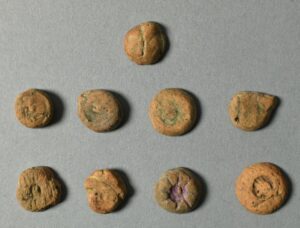
Object Number 21426.4 Obverse Courtesy of the Penn Museum[9]
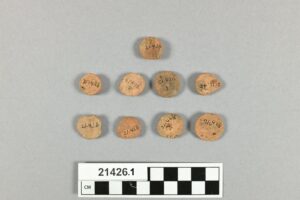
Object Number 21426.4 Reverse Courtesy of the Penn Museum
There is general agreement among scholars that ohajiki probably originated in the Chinese game danqi which dates to the Western Wei dynasty (AD 535-556). It was then introduced to Japan in the Nara period. Danqi is very similar to ohajiki. Of course, the game was originally played with flints, smooth flat river stones, shells, and only later was glass used to make the game pieces[8].
Antique Clay Japanese Ohajiki
The photos above are courtesy of the Penn Museum. These clay ohajiki are from the Ryūkyū Kingdom in the Nansei Islands of Japan[10]. These game pieces were contributed to the Penn Museum by William Henry Furness 3rd in 1898. Dr. Furness, of Philadelphia, (1866 – 1920), was an American physician, ethnographer and author[11].
This is the description provided by the Museum: “Clay discs …half an inch in diameter, flat on one side and rounded on the other. Played by girls. One disc or checker is snapped at another along the ground, and by hitting wins that checker. Dirty pink. Used for the game Ohajiki (御弾き).” If you look closely at the top of the game pieces you will see that some are patterned and look almost like flowers while others have geometric patterns and these have traces of green paint.
We find it interesting that these antique clay game pieces look remarkably like the more modern glass “flowers” featured in the photograph provided by Takomo Noguchi Toritori, in Tokyo, and published in our story “Manzanar: Another Look At Camp Marbles.”
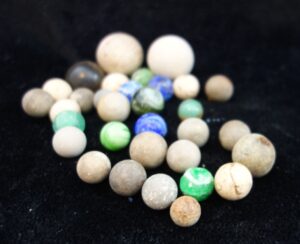
Photograph by Jo Garrett
Marbles & Ohajiki As Cultural Markers
While marbles certainly don’t have Imperial origins and while they were never made from seashells, it is interesting that, like ohajiki game pieces, they did have humble origins in clay, flint, and stone. In fact, for generations of players all marbles were either stone or clay. And the production of clay and stone marbles continued long after glass marbles were invented[12].
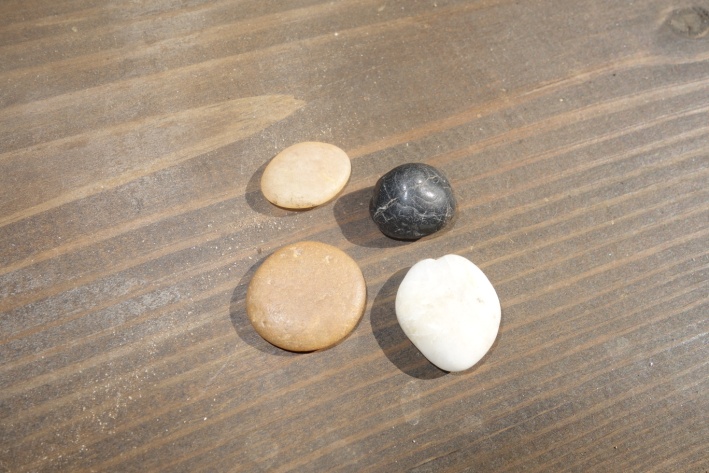
Like marbles, ohajiki first used found stones or cobbles. We have all found smooth flat stones in rivers, lakes, and on an ocean or gulf beach. Well, these require little if any modifications and they can then be used for a very long time. And we have also found round cobbles which require some work but which can rounded into marbles.
Native Americans used cobbles as marbles and as the center for a number of game balls. After reading our story “Native American Marbles and Games” you might also want to read Darren Shell’s A Stone’s Throw beginning from about page four[13].
Both marbles and ohajiki have served as cultural, and to an extent, time markers. These game pieces, both round and flat, have served as signposts in the American and the Japanese cultures for generations. The snapping or flicking game waned after the Nara period but it regained popularity in the Edo period (1603-1868). In America we have seen the popularity of the game of marbles change over time, but it has never disappeared completely.
Speaking of changes over time, both marbles and ohajiki have evolved in response to economic conditions in both countries. Both moved from stone to clay or ceramic with a slip or glaze, and then into glass. And, as we noted above, some ohajiki today are made of plastic. By the time the Meiji restoration (1868 – 1889) had taken place and the Taisho period (1912 – 1926) was already fast approaching, special ohajiki pieces emerged that were made of glass[14].
The Gender Factor
Microsoft Copilot tells us that the gender factor refers to how gender influences and shapes various aspects of life (like social norms, roles, and behavior). We have mentioned that there was a revival of ohajiki in Japan during the Edo period (1603-1868). Well, it was about that time that the game became more of an indoor game played by girls. The Japanese society contrasted the flicking or snapping game against more “aggressive” games for boys[15].
We find it extremely interesting that this same pattern was found in the American culture. Boys played marbles mostly outside in the sand, dirt, mud and muck. It could be a rough and highly contested game and we found some cases of violence arising from game disputes. Marbles was not seen as anything a girl should be a part of and, anyway, girls can’t shoot straight[16].
Playing Ohajiki
We have written a number of stories about marble play in America, and we will only say here that ringer into an actual ring seems to be a predominate way to shoot marbles. Ohajiki, by contrast, is an extremely easy game to learn and to play.
While Ohajiki can be played alone, it is generally played by two or more girls. The objective, like in ringer marbles, is to hit other pieces. When playing, make a circle with your thumb and index finger (or middle finger), then flick one piece with your thumb. These are the rules:
- All players lay down the same number of ohajiki pieces on a flat surface, and then do jan-ken (rock, paper, scissors) to decide the order of play.
- The first person to take a turn gathers everyone’s pieces, using one hand, and then scatters them on the surface.
- The player then indicates two pieces, and draws an imaginary line between them to show how he or she intends to hit one with the other.
- If the player hits the piece as indicated, he or she keeps it. Otherwise, it is the next person’s turn. At the end of the game, the person with the most pieces is the winner[17].
It’s just that simple!
Piaget Applied To Ohajiki
Jean Piaget’s (1896 – 1980) “…theory of cognitive development viewed play as integral to the development of intelligence in children. His theory of play argues that as the child matures, their environment and play should encourage further cognitive and language development.[18]”.
Piaget proposed three main stages of awareness: the absence of any consciousness about the rules, its conception as immanent in origin and therefore immutable and, finally, consciousness of the rules as the product of mutual agreement among players involved. Although he suggested the same trend of development for both kinds of knowledge in boys and girls his results showed a surprising lack of the codification stage in girls’ games and a premature conception of the rules as the mere agreement among players, almost two years earlier than the boys. The mechanism which brings about these changes is cooperation. A sharp contrast is made between unilateral respect and mutual respect in the child’s interactions with others. It is only the latter, as it exists among children, that allows cooperation to come into existence. The age differences between equivalent stages of knowledge in boys and girls was explained as a consequence of their sex and their preferences for complex (boys) or simple (girls) games[19].
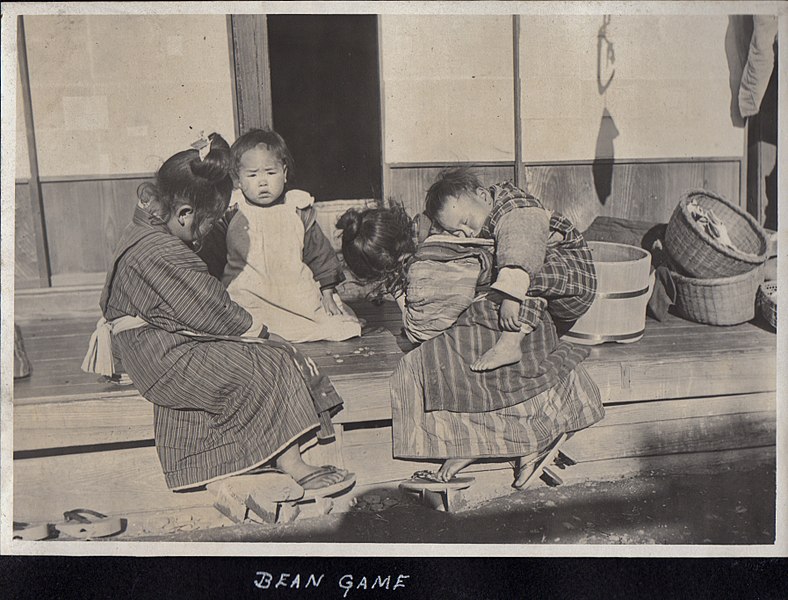
With this simple analysis in mind, it seems to us that the game of ohajiki is tailor-made for young girls! We have to keep in mind that, like this antique photograph shows, girls are often expected to perform a number of set tasks in the home such as child care for younger siblings, and ohajiki, with its informal game pieces and relaxed rules, helps girls both learn and develop skills while multitasking.
Microsoft Copilot explains that playing ohajiki can teach a girl quite a bit. There is the expected eye-hand coordination which boys learn and develop playing marbles. But, frankly, we cannot imagine that this learning process must be as complex for girls as it must be for boys learning to play marbles. Marble games are simply more complex. And remember, boys are often playing for keeps with their favorite agate which they are determined not to lose!
Ohajiki also fosters patience and strategic thinking. Unfortunately, boys are not all that good at being patient; but critical strategic thinking has saved many an agate.
Since both games must be played with others (yes, boys do practice shooting alone), ohajiki, like marbles, helps build communication and cooperation skills. And since it’s steeped in cultural traditions, ohajiki helps girls connect with and appreciate Japanese culture and heritage.
Ohajiki Sea Glass Jewelry & Marble Fashion
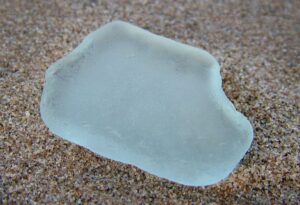
{{Information |Description={{en|Rounded glass on beach.}} |Source=Taken by Chris Howells |Date=September 2005 |Author=Chris Howells
(= Chowells) |Permission=GFDL |other_versions=from en.wikipedia [http://en.wikipedia.org/wiki/Image:R https://creativecommons.org/ 10/25/2024
Jean Forman in “A Sea Glass Journey,” Beach Combing, December 5, 2019, explains that “…sea glass is actually a human-made product that has been recycled into a beautiful item by the tumbling waves and sands of oceans, lakes or rivers as well as the chemical reactions between the ocean’s waters and the glass. It usually takes many years for the glass to become smooth and opaque, so it is no longer sharp or transparent” just like in the photograph above. Forman has a gorgeous and almost unbelievable photograph of sea glass scattered in with the pebbles on a beach.
Yes, glass ohajiki pieces are found on the beaches in Japan and we understand that some kanji like “5” ( 五 ) may be especially exciting to find. We have read that while it is not rare to find the pieces, there are some which are much more difficult to find. We would love to find a more modern glass “flower” piece.
Ohajiki sea glass colors found on the beach in Japan include cornflower blue. Remember, Japan has made glass ohajiki pieces for about as long as America has made glass marbles. We always enjoy a visit to the beach and we love to look for artifacts, so we would fit right in with all those in Japan who out on the beach enjoying this healthy and exhilarating hobby. Just Goggle “Seaglass Ohajiki” to see some of the fantastic stuff being found!
Ohajiki Jewelry
As you can imagine ohajiki jewelry is gorgeous! We have been communicating with Amy Guettler from SaltyLassSeaGlass[20] in Edina, Minnesota, while working on this story and we recommend that you start your search in her shop. Amy has a cat’s eye ohajiki as well as those with the stripes or marks across them. And she has at least one seaglass marble! Every single piece of jewelry is different!
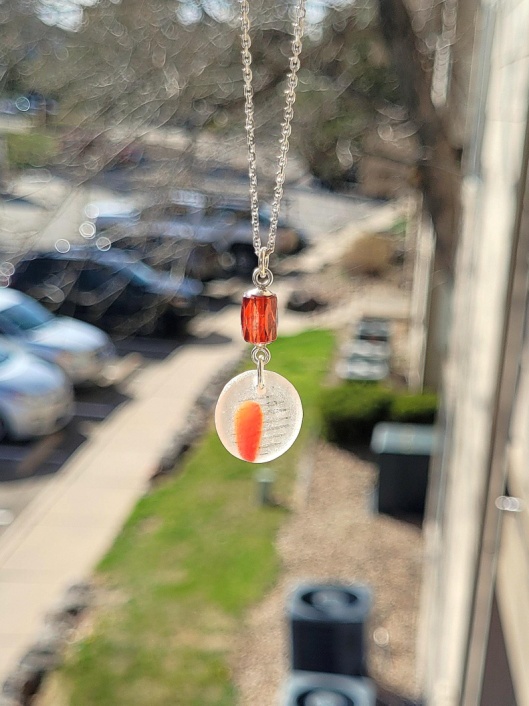
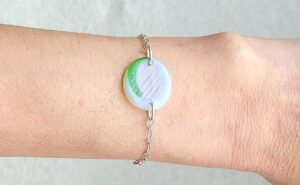
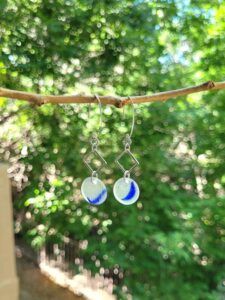
Seaglass Jewelry Photos Courtesy of:
Amy Guettler of SaltyLassSeaGlass[20] in Edina, Minnesota,
Marble Jewelry
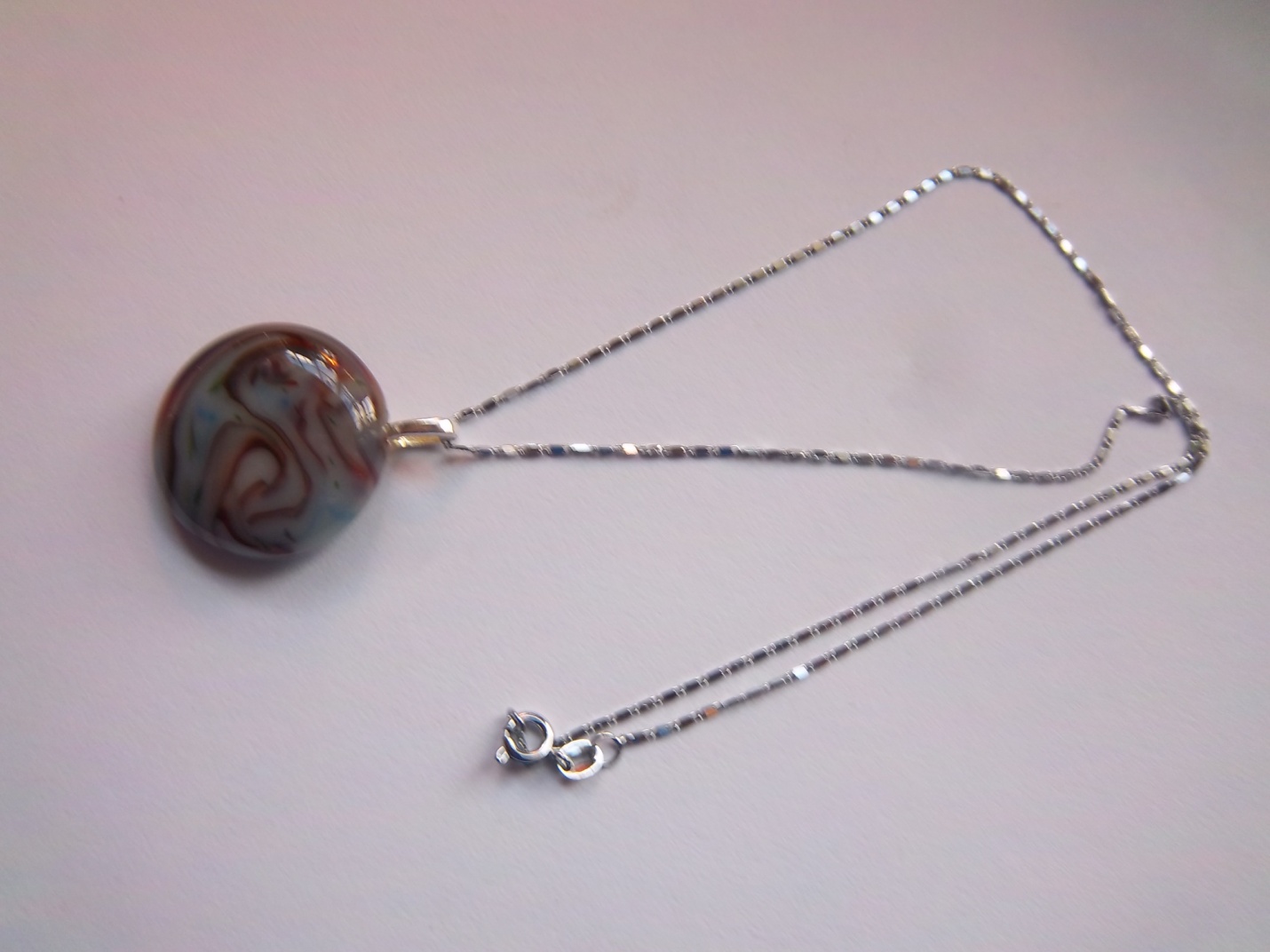
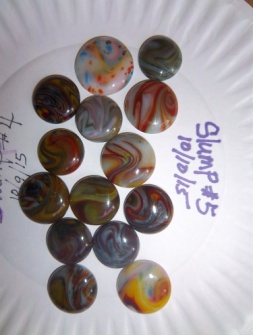
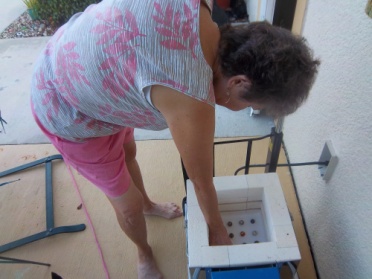
Pendants & Photographs by Jo Garrett
In 2015 we “helped” Dave McCullough (deceased, 2024) run marbles for us. The run is called Everglades. Sometime later we bought a small kiln and Jo ran different styles of our marbles, which range from dark blue to green and bright sky colors. This pendant is one example of her beautiful work.
One of the reasons that Jo wanted to make marble jewelry is because we have collected marble-based fashion for over twenty years. Some is remarkably old. For example, we have a pewter necklace formed by a turtle design with a marble inside.
We have a capped crackle clear marble from about the 1940s and an Avon ring from 1972 called a Fling. It has interchangeable marbles in white, turquoise, and coral and the gold tone sparkles like it is new. We have a set of Chinese Mid Autumn Festival with a Moon Dragon in pursuit of jadeite marbles. We even have a letter opener capped in a wreath and inside it is a beautiful oxblood on silver player marble!
Ending At The Beginning
Remember the title of this story? “Ohajiki: ‘Looks Like Flat Marbles to Me!’ Well, it is true: some modern glass ohajiki do look very much like player marbles. We have no idea whether the game pieces started as glass orbs and were thenmelted flat, or if pressed into a mold. Perhaps they were never marbles at all. We do know that there are glass Cat’s Eye ohajiki as well as all manner which look like Marble King Marine Crystals.
But you know what? It doesn’t matter a whit to ohajiki players. They have been at it for generations and they can use flat pebbles, sea shells, clay “checkers”, or pieces of oddly shaped sea glass. Ohajiki players are much less picky about their game pieces than marble players.

We hope you enjoyed our look at the two games from two cultures side by side. We learned a lot and we hope that you did, too.
- No changes have been made to this photograph. A Davey tells us about the photograph: His father-in-law Elster Hinton was a salesman for the Atkins Saw Company, Cleveland, Ohio. In the early 20th century he traveled to the Far East to sell commercial sawmills and he collected photographs, clippings, and other ephemera. ↑
- “Ohajiki; A Simple, Traditional, Japanese Game.” by YABAI Writers http://yabai.com/p/4178 10/14/2024 ↑
- There are a number of excellent sites where you can learn about Go. For example check Britannica @ https://www.britannica.com/topic/go-game 10/21/2024 ↑
- For example see http://yabai.com/p/4178 10/16/2024 ↑
- https://www.britannica.com/event/Nara-period ↑
- For a fascinating and comprehensive analysis of “The Chinese Leaf Game” see David Parlett @ The Chinese “Leaf” Game, surveyed by David Parlett 10/21/2024 ↑
- http://yabai.com/p/4178 10/16/2024 ↑
- Ohajiki – Wikipedia (10/21/2024); Japanese Traditional Game “Ohajiki” – JapanUp! magazine (10/21/2024); “Nara Period Japanese History @ https://www.britannica.com/event/Nara-period (10/21/2024) & “Traditional Chinese Games” @ Chinese Historical & Cultural Project – Traditional Chinese Games (10/21/2024) ↑
- A special thank you to Evan Peugh, Assistant Archivist, Penn Museum, University of Pennsylvania Museum of Archaeology and Anthropology, Philadelphia. ↑
- The Ryūkyū was fascinating and the Islands are gorgeous. Why not take a couple of minutes to read about it? “For 450 years, the Ryūkyū Kingdom flourished as an independent state that governed the Nansei islands in what is now the southernmost part of Japan. This small maritime nation, made up of a string of islands between Kyūshū and Taiwan, became a tributary state of Ming China in the second half of the fourteenth century, and developed into a major entrepôt on the East Asian trade routes, importing and reselling articles from nations across East and Southeast Asia.” @ https://www.nippon.com/en/japan-topics/g00949/ 10/22/2024 ↑
- https://en.wikipedia.org/wiki/William_Henry_Furness_III 10/22/2024 ↑
- If you are interested in clay and stone marbles then we recommend that you read “Native American Marbles and Games.” @ https://thesecretlifeofmarbles.com/native-american-marbles-games/ 10/22/2024 ↑
- Darren Shell’s A Stone’s Throw The History of the Game of Marbles in the Upper Cumberland Region of Tennessee and Kentucky. Martinsville, IN: Fideli Publishing, 2009. ↑
- http://yabai.com/p/4178 (10/16/2024). This article does a comprehensive job of analyzing how ohajiki has influenced Japanese culture over time. In this eMagazine we have considered the role of marbles in the Revolutionary and Civil Wars as well as in the hard times of the Depression. If you haven’t read them then we recommend these stories: “The Long Last Ride & A Well-Contested Game of Marbles”; “A.L. Dyke: Man of Mystery”; “Marbles in the Saddlebag”; “Time Rolls Like a Marble: Marbles in Colonial America & the Revolution”; “Repeating Torpedo Marbles”; “Once Upon of Time in America”; and “Marbles Used as Munitions in the American Civil War.” ↑
- Ohajiki – Wikipedia 10/24/2024 ↑
- We put this myth to rest in our story “Girls are a Crack Shot With a Marble” https://thesecretlifeofmarbles.com/girls-are-crack-shots-with-a-marble/ 10/25/2024 ↑
- https://web-japan.org/nipponia/nipponia26/en/topic/index.html (10/16/2024)

NIPPONIA No.26 September 15, 2003. - https://www.pentagonplay.co.uk/news-and-info/psychology-learning-through-play (10/25/2024). See also Jean Piaget | Biography, Theory, & Facts | Britannica (10/25/2024) & Linaza, José Luis. “Piaget’s Marbles: the study of children’s games and their knowledge of rules.” (2016) @ Piaget’s Marbles: the study of children’s games and their knowledge of rules | Semantic Scholar 10/18/2024 ↑
- Linaza ↑
- https://www.etsy.com/shop/SaltyLassSeaGlass 10/25/2024 ↑

